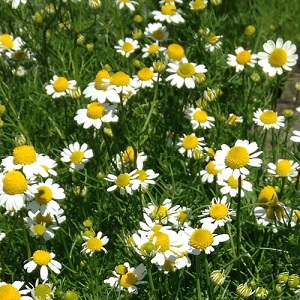
Roman Chamomile is a fantastic garden and herbal/medicinal plant. It has aromatic feathery leaves and bright white daisy-like flowers from July to August. Plants grow to a height of about 20cm and spread out nicely to form an effective ground cover or lawn. The flowers can be picked, dried and used as a herbal tea, with an appealing herbaceous apple-like flavour. See also German Chamomile, a popular choice for herbal tea.
Roman Chamomile grows best in a sunny position in well drained soil, with enough water during the growing season. Lawns tolerate light foot traffic.
Pack of approx 1500 small seeds. Sow the seeds directly into cultivated soil in autumn (in warmer gardens) or spring. Sowing instructions and a colour photo are printed on the packet.
See how your seeds are packed.
| Hardiness |
Hardy evergreen perennial |
| Flowers |
June to August |
| Height |
15 - 25cm |
| Spread |
20 - 40cm |
| Conditions |
Grow in a sunny position in well drained soil, with sufficient moisture during the growing season |
| Sow |
Sow the seeds in autumn (warmer gardens) or spring directly into cultivated ground. Rake over lightly and keep moist, but not waterlogged. Germination takes 2-4 week, and depends on the air temperature. Allow 1000 seeds per square metre for lawns and thin out plants to about 10cm apart. Or sow the seeds into seed trays in spring and summer. Press the seeds into the surface of the compost, do not cover with compost and keep at 15-20°C. Plant out into the garden after the last frost. |
| Grow |
These are trouble-free plants once established and spread out naturally over time. Lawns can be trimmed back regularly to maintain a good appearance. If growing the plants for flowers, do not trim back, and pick the flowerheads when in full bloom, and dry for a week or so before storing in a sealed container. This tea is also effective at preventing damping off of seedlings, and can be used a natural damping-off treatment in the greenhouse. Trim back the plants after picking the flowers. Plants can be divided in spring by finding creeping stems that have rooted. The rooted sections can be separated from the parent plant and grown on. |
|
